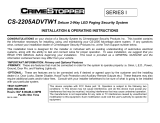
INSTALLER MANUAL
2.1 – 20-PIN CONNECTOR
2.2 – 8-PIN CONNECTOR
1.0 – INTRODUCTORY NOTE………………………………………………………........ PAGE 03
INSTALLER MANUAL
2.0 - PINOUT TABLES.................................................................................................... PAGE 06
2.1 - 20-way connector................................................................................................. PAGE 06
2.2 - 8-way connector.................................................................................................... PAGE 06
3.0 - WIRING DIAGRAM………………............................................................................. PAGE 07
4.0 - TURN INDICATOR WIRING DIAGRAMS….......................................................... PAGE 08
4.1 - Standard connections.......................................................................................... PAGE 08
4.2 - Connections for vehicles with separate lines........................................................ PAGE 08
4.3 - Connection to Hazard switch................................................................................ PAGE 08
5.0 - CENTRAL LOCKING CONNECTIONS TO ARM/DISARM THE SYSTEM.................
5.1 - Connections and management via CAN-BUS line................................................. PAGE 09
.
5.2 - Connections to locking motors................................................................................ PAGE 09
5.3 - Connections to turn indicators................................................................................ PAGE 09
5.4 - Combination connection......................................................................................... PAGE 09
6.0 - VEHICLE CODE PROGRAMMING…........................................................................ PAGE 09
7.0 - LEARNING OF TURN INDICATORS FLASHES........................................................ PAGE 1
8.0 - SYSTEM PROGRAMMING....................................................................................... PAGE 11
8.1 - Optical signals......................................................................................................... PAGE 1
8.2 - Acoustic signals...................................................................................................... PAGE 12
8.3 - Passive arming....................................................................................................... PAGE 12
8.4 - Enabling siren output………………….................................................................. PAGE 12
8.5 – Double pulse unlock……….................................................................................... PAGE 12
8.6 – Inhibit input………………………………………………………………...................... PAGE 12
9.0 - SYSTEM PROGRAMMING EXAMPLE...................................................................... PAGE
10.0 - ADDING NEW DEVICES......................................................................................... PAGE
11.0 - DELETING PROGRAMMED DEVICES................................................................... PAGE
12.0 - ULTRASONIC VOLUMETRIC PROTECTION......................................................... PAGE
12.1 – Connection and positioning .................................................................................. PAGE 15
12.2 – Sensor Adjustment .............................................................................................. PAGE 15
13.0 – SYSTEM RESET …………………………..............................................................
14.0 – WASTE ELECTRICAL AND ELECTRONIC EQUIPMENT (WEEE) DIRECTIVE
15.0 – TECHNICAL SPECIFICATIONS …………………………………………………………
Please read the present manual carefully to familiarize yourself fully with the alarm system features
and operating procedures and do keep it handy for future reference.
NB: Optional remote controls are available to operate the alarm system and the CDL, only where
negative CDL connection is available (see par. 2.0 PINOUT TABLES).
The following symbols are included in the present Manual to emphasize important instructions:
TABLE OF CONENTS
1.0
INTRODUCTORY NOTE
For the installer.
This sign indicates that the system will work according to the connections and the
programming selected or it simply provides useful installation tips.
2.0
PINOUT TABLES
WHITE-ORANGE wire must ALWAYS be connected if system is to arm/disarm
via the turn indicators.
PAGE 02
PAGE 03
PAGE 03
PAGE 03
PAGE 04
PAGE 05
PAGE 05
PAGE 05
PAGE 05
PAGE 06
PAGE 06
PAGE 06
PAGE 06
PAGE 06
PAGE 07
PAGE 08
PAGE 09
PAGE 09
PAGE 09
PAGE 09
PAGE 09
PAGE 09
PAGE 09
PAGE 10
PAGE 11
PAGE 11
PAGE 12
PAGE 12
PAGE 12
PAGE 12
PAGE 13
PAGE 13
PAGE02PAGE03
PAGE02PAGE03









